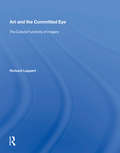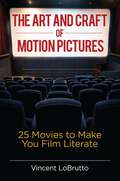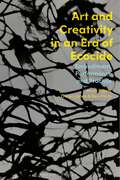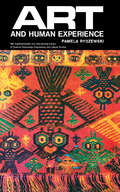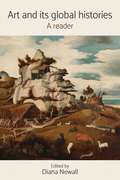- Table View
- List View
Art And The Committed Eye: The Cultural Functions Of Imagery
by Richard LeppertIn Art and the Committed Eye Richard Leppert examines Western European and American art from the fifteenth to the twentieth century. He studies the complex relation between the "look" of images and the variety of social and cultural uses to which they are put and demonstrates that the meaning of any image is significantly determined by its function, which changes over time. In particular, he emphasizes the ways in which visual culture is called on to mediate social differences defined by gender, class, and race. In , Leppert addresses the nature and task of representation, discussing how meaning accrues to images and what role vision and visuality play in the history of modernity. Here he explains imagery's power to attract our gaze by triggering desire and focuses on the long history of the use of representation to enact a deception, whether in painting or advertising. explores art's relation to the material world, to the ways in which images mark our various physical and psychic ties to objects. The author analyzes still life paintings whose subject matter is both extraordinarily diverse and deeply paradoxical—from flower bouquets to grotesque formal arrangements of human body parts. Leppert demonstrates that even in "innocent" still lifes, formal design and technical execution are imbued with cultural conflict and social power. is devoted to the representation of the human body—as subject to obsessive gazing and as an object of display, spectacle, and transgression. The variety of body representation is enormous: pleased or tortured, gorgeous or monstrous, modest or lascivious, powerful or weak, in the bloom of life or under the anatomist's knife, clothed or naked. But it is the sexual body, Leppert shows, that has provided the West with its richest, most complex, contradictory, conflicted, and paradoxical accounts of human identity in relation to social ideals.
The Art and Craft of Motion Pictures: 25 Movies to Make You Film Literate
by Vincent LoBruttoThis volume can rightfully be called "a film school in a single book." Investigating and analyzing the elements and concepts of motion picture creation, this book looks closely at 25 films that represent a wide range of styles and subjects.Although most motion picture viewers have seen numerous movies in their lifetime, few in the general public have a firm and deep understanding of how motion pictures are created, or a grasp of the intricacies of cinematic storytelling and content. By presenting 25 films, American and international, Hollywood and independent, this book educates and enlightens readers about the details of the motion picture creation process.Some readers will have viewed certain films in the volume, but many will be introduced to major cinematic works within the canon of great and essential films for the very first time. Topics explored include animation, period films, editing, directorial style, and non-linear cinematic structure. Readers will learn about the origin of the jump cut in Breathless, time and space in Hiroshima Mon Amour, and the editing in Orson Welles's essay film F is for Fake. The Art and Craft of Motion Pictures: 25 Movies to Make You Film Literate will educate the novice and avid moviegoer alike about the inner workings of this dynamic, popular, and culturally significant art form.
The Art and Craft of Motion Pictures: 25 Movies to Make You Film Literate
by Vincent LoBruttoThis volume can rightfully be called "a film school in a single book." Investigating and analyzing the elements and concepts of motion picture creation, this book looks closely at 25 films that represent a wide range of styles and subjects.Although most motion picture viewers have seen numerous movies in their lifetime, few in the general public have a firm and deep understanding of how motion pictures are created, or a grasp of the intricacies of cinematic storytelling and content. By presenting 25 films, American and international, Hollywood and independent, this book educates and enlightens readers about the details of the motion picture creation process.Some readers will have viewed certain films in the volume, but many will be introduced to major cinematic works within the canon of great and essential films for the very first time. Topics explored include animation, period films, editing, directorial style, and non-linear cinematic structure. Readers will learn about the origin of the jump cut in Breathless, time and space in Hiroshima Mon Amour, and the editing in Orson Welles's essay film F is for Fake. The Art and Craft of Motion Pictures: 25 Movies to Make You Film Literate will educate the novice and avid moviegoer alike about the inner workings of this dynamic, popular, and culturally significant art form.
The Art and Craft of Policy Analysis: Reissued with a new introduction by B. Guy Peters
by Aaron WildavskyThe Art and Craft of Policy Analysis is a classic work of the Public Policy discipline. Wildavsky’s emphasis on the values involved in public policies, as well as the need to build political understandings about the nature of policy, are as important for 21st century policymaking as they were in 1979. B. Guy Peters’ critical introduction provides the reader with context for the book, its main themes and contemporary relevance, and offers a guide to understanding a complex but crucial text.
The Art and Craft of Policy Analysis (pdf): Reissued With A New Introduction By B. Guy Peters
by Aaron WildavskyThe Art and Craft of Political Theory
by Leslie Paul ThieleThe Art and Craft of Political Theory provides a critical overview of the discipline’s core concepts and concerns and highlights its development of critical thinking and practical judgment. The field’s interdisciplinary strengths are deployed to grapple with emerging issues and engage afresh enduring ideals and quandaries. While conventional definitions of key concepts are provided, original and controversial perspectives are also explored, revealing continuity in a tradition of thought while emphasizing its diversity and innovations. The Art and Craft of Political Theory illustrates the analytic and interpretive skills, the moral and philosophic discernment, and the historical knowledge needed to appreciate a tradition of thought, to contest its claims, and to make good use of its insights. Topics include: science, ideology and normative theory biology, culture, human nature, power and violence ancient, modern and postmodern political thought liberty, equality, justice, reason and democracy racial, religious, gender and economic identities liberalism, socialism, capitalism, communism, anarchism, feminism and environmentalism social media, automation, artificial intelligence and other emerging technologies. This concise, lively and accessibly written book is essential reading for all students of political theory.
The Art and Craft of Political Theory
by Leslie Paul ThieleThe Art and Craft of Political Theory provides a critical overview of the discipline’s core concepts and concerns and highlights its development of critical thinking and practical judgment. The field’s interdisciplinary strengths are deployed to grapple with emerging issues and engage afresh enduring ideals and quandaries. While conventional definitions of key concepts are provided, original and controversial perspectives are also explored, revealing continuity in a tradition of thought while emphasizing its diversity and innovations. The Art and Craft of Political Theory illustrates the analytic and interpretive skills, the moral and philosophic discernment, and the historical knowledge needed to appreciate a tradition of thought, to contest its claims, and to make good use of its insights. Topics include: science, ideology and normative theory biology, culture, human nature, power and violence ancient, modern and postmodern political thought liberty, equality, justice, reason and democracy racial, religious, gender and economic identities liberalism, socialism, capitalism, communism, anarchism, feminism and environmentalism social media, automation, artificial intelligence and other emerging technologies. This concise, lively and accessibly written book is essential reading for all students of political theory.
Art and Creativity in an Era of Ecocide: Embodiment, Performance and Practice
by Anna Pigott, Owain Jones and Ben ParryWhat can creativity achieve in an era of ecocide? How are people using creative and artistic practices to engage with (and resist) the destruction of life on earth? What are the relationships between creativity and repair in the face of escalating global environmental crises? Across twelve compelling case studies, this book charts the emergence of diverse forms of artistic practice and brings together accounts of how artists, scholars and activists are creatively responding to environmental destruction.Highlighting alternative approaches to creativity in both conventional art settings and daily life, the book demonstrates the major influence that ecological thought has had on contemporary creative practices. These are often more concerned with subtle processes of feeling, experience and embodiment than they are with charismatic 'eco-art' works. In doing so, this exploratory book develops a conception of creativity as an anti-ecocide endeavour, and provides timely theoretical and practical insights on art in an age of environmental destruction.
Art and Creativity in an Era of Ecocide: Embodiment, Performance and Practice
What can creativity achieve in an era of ecocide? How are people using creative and artistic practices to engage with (and resist) the destruction of life on earth? What are the relationships between creativity and repair in the face of escalating global environmental crises? Across twelve compelling case studies, this book charts the emergence of diverse forms of artistic practice and brings together accounts of how artists, scholars and activists are creatively responding to environmental destruction.Highlighting alternative approaches to creativity in both conventional art settings and daily life, the book demonstrates the major influence that ecological thought has had on contemporary creative practices. These are often more concerned with subtle processes of feeling, experience and embodiment than they are with charismatic 'eco-art' works. In doing so, this exploratory book develops a conception of creativity as an anti-ecocide endeavour, and provides timely theoretical and practical insights on art in an age of environmental destruction.
Art and Culture in the Multiverse of Metaverses: Immersion, Presence, and Interactivity in the Digital Age (Springer Series on Cultural Computing)
by James HutsonDrawing on the art historical framing of Location, Place, and Identity, this book will examine how the factors of Immersion, Presence, and Interactivity of XR are shaping our understanding of the world and our place within it. Location refers to the specific geographical or spatial context in which a work of art is created or experienced. Place refers to the social, cultural, and historical context of that location. Identity refers to the ways in which individuals and communities construct and express their sense of self and belonging within those contexts. Through case studies and theoretical analysis, Art and Culture in the Multiverse of Metaverses - Immersion, Presence, and Interactivity in the Digital Age, will explore how the factors of Immersion, Presence, and Interactivity of XR can be aligned with these art historical concepts, providing new opportunities for understanding and engaging with Location, Place, and Identity. For example, XR can be used to create immersive experiences of historical locations and cultural sites, allowing users to explore and engage with them in ways that would otherwise be impossible. Additionally, XR can be used to create interactive artworks that engage with issues of identity and belonging, creating new possibilities for self-expression and exploration.
Art and Eloquence in Byzantium (Princeton Legacy Library #5253)
by Henry MaguireIn this interdisciplinary study, Henry Maguire examines the influence of several literary genres and rhetorical techniques on the art of narration in Byzantium. He reveals the important and wide-reaching influence of literature on the visual arts. In particular, he shows that the literary embellishments of the sermons and hymns of the church nourished the imaginations of artists, and fundamentally affected the iconography, style, and arrangement of their work. Using provocative material previously unfamiliar to art historians, he concentrates on religious art from A.D. 843 to 1453.Professor Maguire first considers the Byzantine view of the link between oratory and painting, and then the nature of rhetoric and its relationship to Christian literature. He demonstrates how four rhetorical genres and devices—description, antithesis, hyperbole, and lament—had a special affinity with the visual arts and influenced several scenes in the Byzantine art, including the Annunciation, the Nativity, the Massacre of the Innocents, the Presentation, Christ's Passion, and the Dormition of the Virgin.Through the literature of the church, Professor Maguire concludes, the methods of rhetoric indirectly helped Byzantine artists add vividness to their narratives, structure their compositions, and enrich their work with languages. Once translated into visual language, the artifices of rhetoric could be appreciated by many.Henry Maguire is Assistant Professor of Art History at the University of Illinois at Urbana-Champaign.Originally published in 1982.The Princeton Legacy Library uses the latest print-on-demand technology to again make available previously out-of-print books from the distinguished backlist of Princeton University Press. These editions preserve the original texts of these important books while presenting them in durable paperback and hardcover editions. The goal of the Princeton Legacy Library is to vastly increase access to the rich scholarly heritage found in the thousands of books published by Princeton University Press since its founding in 1905.
Art and Eloquence in Byzantium (Princeton Legacy Library #5253)
by Henry MaguireIn this interdisciplinary study, Henry Maguire examines the influence of several literary genres and rhetorical techniques on the art of narration in Byzantium. He reveals the important and wide-reaching influence of literature on the visual arts. In particular, he shows that the literary embellishments of the sermons and hymns of the church nourished the imaginations of artists, and fundamentally affected the iconography, style, and arrangement of their work. Using provocative material previously unfamiliar to art historians, he concentrates on religious art from A.D. 843 to 1453.Professor Maguire first considers the Byzantine view of the link between oratory and painting, and then the nature of rhetoric and its relationship to Christian literature. He demonstrates how four rhetorical genres and devices—description, antithesis, hyperbole, and lament—had a special affinity with the visual arts and influenced several scenes in the Byzantine art, including the Annunciation, the Nativity, the Massacre of the Innocents, the Presentation, Christ's Passion, and the Dormition of the Virgin.Through the literature of the church, Professor Maguire concludes, the methods of rhetoric indirectly helped Byzantine artists add vividness to their narratives, structure their compositions, and enrich their work with languages. Once translated into visual language, the artifices of rhetoric could be appreciated by many.Henry Maguire is Assistant Professor of Art History at the University of Illinois at Urbana-Champaign.Originally published in 1982.The Princeton Legacy Library uses the latest print-on-demand technology to again make available previously out-of-print books from the distinguished backlist of Princeton University Press. These editions preserve the original texts of these important books while presenting them in durable paperback and hardcover editions. The goal of the Princeton Legacy Library is to vastly increase access to the rich scholarly heritage found in the thousands of books published by Princeton University Press since its founding in 1905.
Art and Engagement in Early Postwar Japan
by Justin JestyJustin Jesty’s Art and Engagement in Early Postwar Japan reframes the history of art and its politics in Japan post-1945. This fascinating cultural history addresses our broad understanding of the immediate postwar era moving toward the Cold War and subsequent consolidations of political and cultural life. At the same time, Jesty delves into an examination of the relationship between art and politics that approaches art as a mode of intervention, but he moves beyond the idea that the artwork or artist unilaterally authors political significance to trace how creations and expressive acts may (or may not) actually engage the terms of shared meaning and value.Art and Engagement in Early Postwar Japan centers on a group of social realists on the radical left who hoped to wed their art with anti-capitalist and anti-war activism, a liberal art education movement whose focus on the child inspired innovation in documentary film, and a regional avant-garde group split between ambition and local loyalty. In each case, Jesty examines writings and artworks, together with the social movements they were a part of, to demonstrate how art—or more broadly, creative expression—became a medium for collectivity and social engagement. He reveals a shared if varied aspiration to create a culture founded in amateur-professional interaction, expanded access to the tools of public authorship, and dispersed and participatory cultural forms that intersected easily with progressive movements. Highlighting the transformational nature of the early postwar, Jesty deftly contrasts it with the relative stasis, consolidation, and homogenization of the 1960s.
Art and History: Texts, Contexts and Visual Representations in Ancient and Early Medieval India
by R MahalakshmiArt and History: Texts, Contexts and Visual Representations in Ancient and Early Medieval India seeks to locate the historical contexts of premodern Indian art traditions. The volume examines significant questions, such as: What were the purposes served by art? How were religious and political ideas and philosophies conveyed through visual representations? How central were prescription, technique and style to the production of art? Who were the makers and patrons of art? How and why do certain art forms, meanings and symbols retain a relevanceacross context? With contributions from historians and art historians seeking to unravel the interface between art and history, the volume dwells on the significance of visual representations in specific regional historical contexts, the range of symbolic signification attached to these and the mythologies and textual prescriptions that contribute to the codification and use of representational forms. Supplemented with over 60 images, this volume is a must-read for scholars andresearchers of history and art.
Art and History: Texts, Contexts and Visual Representations in Ancient and Early Medieval India
by R MahalakshmiArt and History: Texts, Contexts and Visual Representations in Ancient and Early Medieval India seeks to locate the historical contexts of premodern Indian art traditions. The volume examines significant questions, such as: What were the purposes served by art? How were religious and political ideas and philosophies conveyed through visual representations? How central were prescription, technique and style to the production of art? Who were the makers and patrons of art? How and why do certain art forms, meanings and symbols retain a relevanceacross context? With contributions from historians and art historians seeking to unravel the interface between art and history, the volume dwells on the significance of visual representations in specific regional historical contexts, the range of symbolic signification attached to these and the mythologies and textual prescriptions that contribute to the codification and use of representational forms. Supplemented with over 60 images, this volume is a must-read for scholars andresearchers of history and art.
Art and Human Experience: The Commonwealth and International Library: Liberal Studies Division
by Pamela RydzewskiArt and Human Experience focuses on the diversity of art traditions which evolved in societies with widely differing cultures. The book first underscores the elements of vision and form in the arts, hunters of the Old Stone Age, and African tribal sculpture, including the art of primitive societies and African sculpture. Suggested readings are presented to further stress the points of the elements of the arts and its evolution and development in various ages and cultures. The text then elaborates on the Amerindian art of Mexico and South America, Egyptian art, and the classical art of Rome and Greece. The book notes that the Amerindian cultures have produced a lot of very fine art, painting, architecture, and sculpture that have caught the attention of artists, thinkers, scholars, and writers since their discovery by the Spaniards. The Egyptians not only excelled in mathematics, medicine, surgery, astronomy, physics, and law but also in architecture and the arts. The Romans have also contributed a lot to the development of art and architecture. The manuscript takes a look at medieval art, the Renaissance, Chinese art, and the post-Renaissance in Europe. The publication is a fine reference for students and researchers interested in the evolution of the arts.
Art and human rights: Contemporary Asian contexts (PDF) (Rethinking Art's Histories)
by Jen Webb Caroline TurnerContemporary Asian art has had a remarkable impact on global art practice, in addition to serving as a record of the region’s history from decolonisation to the present. Many Asian artists are deeply concerned about what it means to be human and to contribute to the development of a sustainable society, as well as having a sustained commitment to making art. This book, written at the start of the ‘Asian century’, focuses on the contexts and conditions which have helped to shape both art practice and postcolonial society in the region. One of the first surveys of contemporary Asian art, it uses case studies of key artists to discuss the work in relation to issues of human rights, social and environmental well-being and creativity. As such, it makes an important contribution to studies of contemporary Asian art and art history.
Art and human rights: Contemporary Asian contexts (Rethinking Art's Histories)
by Jen Webb Caroline TurnerContemporary Asian art has had a remarkable impact on global art practice, in addition to serving as a record of the region’s history from decolonisation to the present. Many Asian artists are deeply concerned about what it means to be human and to contribute to the development of a sustainable society, as well as having a sustained commitment to making art. This book, written at the start of the ‘Asian century’, focuses on the contexts and conditions which have helped to shape both art practice and postcolonial society in the region. One of the first surveys of contemporary Asian art, it uses case studies of key artists to discuss the work in relation to issues of human rights, social and environmental well-being and creativity. As such, it makes an important contribution to studies of contemporary Asian art and art history.
Art and Identity in Spain, 1833–1956: The Orient Within
by Claudia HopkinsRichly illustrated, this is the first study in English to explore the longevity of Orientalist art in Spain over a period of 120 years.It highlights how artists in Spain shaped perceptions of Al-Andalus (Iberia under Islam 711–1492) and northern Morocco, from Spain's liberal revolution of the 1830s to the end of the Protectorate of Morocco in 1956. Combining art history with a cultural studies approach, and using exemplary case studies, Hopkins foregrounds the diverse issues that underpin Orientalist expression: reflections on history and the nation, cultural nationalism, gender and sexuality, aesthetics and art commerce, colonialism and racial thinking. In the process, the book challenges over-familiar understandings of Western Orientalism.Beyond Fortuny and Sorolla, many unfamiliar artists and exhibitions are introduced, amongst them Villaamil, whose nostalgic landscapes evoked the loss of Andalusi culture; Bécquer, who celebrated Spanish-Moroccan peace-making through the lens of Velázquez; the Symbolist Rusiñol, whose images of the Alhambra are infused with melancholy; Morcillo, whose extraordinary camp images opened a new space for male subjectivity; Tapiró and Bertuchi, who dedicated their lives to Morocco, and the Moroccan Sarghini, who participated in the state-funded Painters of Africa exhibitions in Franco's Madrid – an annual exhibition that served the colonial concept of a Hispano-Moroccan brotherhood under the dictatorship.This book traces the shifting impulses and meanings of Orientalist expression in Spain. It makes an original intervention in the field of Spanish art studies and contributes new material to the ongoing debates about Western Orientalism.
Art and Illusion: A Study in the Psychology of Pictorial Representation - Millennium Edition (The A. W. Mellon Lectures in the Fine Arts #5)
by E. H. GombrichA groundbreaking account of perception and art, from one of the twentieth century’s most important art historiansE. H. Gombrich is widely considered to be one of the most influential art historians of the twentieth century, and Art and Illusion is generally agreed to be his most important book. Bridging science and the humanities, this classic work examines the history and psychology of pictorial representation in light of modern theories of information and learning in visual perception. Searching for a rational explanation of the changing styles of art, Gombrich reexamines ideas about the imitation of nature and the function of tradition. In testing his arguments, he ranges over the history of art, from the ancient Greeks, Leonardo, and Rembrandt to the impressionists and the cubists. But the triumphant originality of Art and Illusion is that Gombrich is less concerned with the artists than with the psychological experience of the viewers of their work.Please note: All images in this ebook are presented in black and white and have been reduced in size.
Art and Institution: Aesthetics in the Late Works of Merleau-Ponty (Continuum Studies in Continental Philosophy)
by Rajiv KaushikArt and Institution examines how for Merleau-Ponty the work of art opens up, without conceptualizing, the event of being. Rajiv Kaushik treats Merleau-Ponty's renderings of the artwork - specifically in his later writings during the period ranging from 1952-1961 - as a path into the being that precedes phenomenology. Replete with references to Merleau-Ponty's reflections on Matisse, Cézanne, Proust and others, and featuring Kaushik's own original reflections on various artworks, this book is guided by the notion that art does not iterate the findings of phenomenology so much as it allows phenomenology to finally discover what, as a matter of principle, it seeks: the very foundation of experience that is not itself available to thought. Kaushik is thus concerned with the ways in which the work of art restores the principle of institution, prior to the intentional structures of consciousness, so that phenomenology may settle questions concerning ontological difference, the origination of significance, and the relationship between interiority and exteriority.
Art and Institution: Aesthetics in the Late Works of Merleau-Ponty (Continuum Studies in Continental Philosophy)
by Rajiv KaushikArt and Institution examines how for Merleau-Ponty the work of art opens up, without conceptualizing, the event of being. Rajiv Kaushik treats Merleau-Ponty's renderings of the artwork - specifically in his later writings during the period ranging from 1952-1961 - as a path into the being that precedes phenomenology. Replete with references to Merleau-Ponty's reflections on Matisse, Cézanne, Proust and others, and featuring Kaushik's own original reflections on various artworks, this book is guided by the notion that art does not iterate the findings of phenomenology so much as it allows phenomenology to finally discover what, as a matter of principle, it seeks: the very foundation of experience that is not itself available to thought. Kaushik is thus concerned with the ways in which the work of art restores the principle of institution, prior to the intentional structures of consciousness, so that phenomenology may settle questions concerning ontological difference, the origination of significance, and the relationship between interiority and exteriority.
Art and its global histories: A reader (Art And Its Global Histories Ser.)
by Diana NewallA varied selection of content, including excerpts, new translations, interviews with curators and artists, and art criticism. The Reader is contextualised under key themes and ideas that underpin the notion of a global art history that spans from the 1400s to present day.
Art and Its Publics: Museum Studies at the Millennium (New Interventions in Art History)
by Andrew McClellanBringing together essays by museum professionals and academics from both sides of the Atlantic, Art and its Publics tackles current issues confronting the museum community and seeks to further the debate between theory and practice around the most pressing of contemporary concerns. Brings together essays that focus on the interface between the art object, its site of display, and the viewing public. Tackles issues confronting the museum community and seeks to further the debate between theory and practice. Presents a cross-section of contemporary concerns with contributions from museum professionals as well as academics. Part of the New Interventions in Art History series, published in conjunction with the Association of Art Historians.
Art and knowledge after 1900: Interactions between modern art and thought
by James Fox Vid SimonitiThis ground-breaking new history of modern art explores the relationship between art and knowledge from the beginning of the twentieth century to the present day. Each chapter examines artistic responses to a particular discipline of knowledge, from quantum theory and theosophy to cybernetics and ethnic futurisms. The authors argue that art’s incursion into other intellectual disciplines is a defining characteristic of both modernism and postmodernism. Throughout, the volume poses a series of larger questions: is art a source of knowledge? If so, what kind of knowledge? And, ultimately, can it contribute to our understanding of the world in ways that thinkers from other fields should take seriously?
